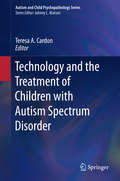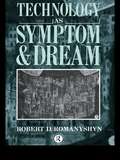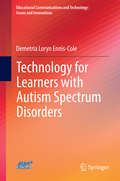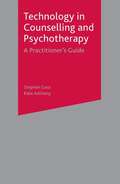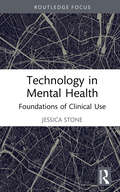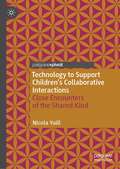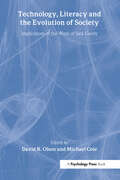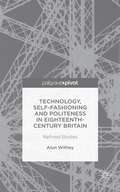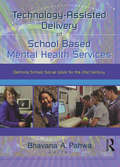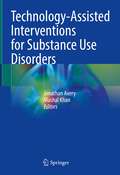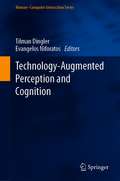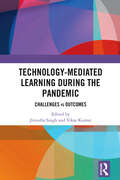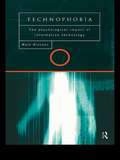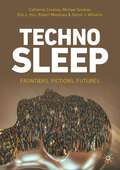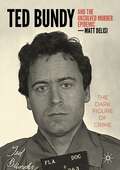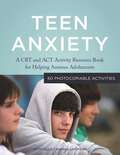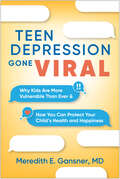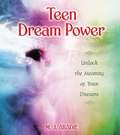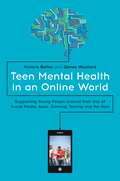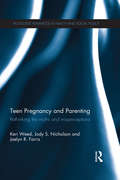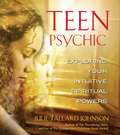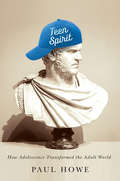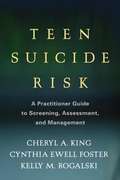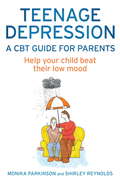- Table View
- List View
Technology and the Treatment of Children with Autism Spectrum Disorder
by Teresa A. CardonThis volume analyzes recent technological breakthroughs in aiding children with autism spectrum disorder (ASD). Chapters offer practical guidance in such areas as assessment, treatment planning, and collaborative intervention. The book also presents findings on hardware and software innovations and emphasizes their effectiveness in clinical practices that are targeted to specific cognitive, social, academic and motor skill areas. In addition, it describes promising new deficit-reducing and skill-enhancing technologies on the horizon. Featured topics include: Developing and supporting the writing skills of individuals with ASD through assistive technologies. The ways in which visual organizers may support executive function, abstract language comprehension and social learning. Do-as-I'm-doing situations involving video modeling and autism. The use of technology to facilitate personal, social and vocational skills in youth with ASD. Evidence-based instruction for students with ASD. The use of mobile technology to support community engagement and independence. Technology and Treatment of Children with Autism Spectrum Disorder is an essential resource for clinicians and related professionals as well as researchers and graduate students across such disciplines as child and school psychology, rehabilitation medicine, educational technology, occupational therapy, speech pathology and social work.
Technology as Symptom and Dream
by Robert RomanyshynThe development of linear perspective in the 15th century represented a radical transformation in the European's sense of the world, the body and the self. Robert Romanyshyn's latest book examines the claim that the development of linear perspective vision was and is indispensable to the emergence of our technological world. It does so by telling the story of how an artistic technique has become a cultural habit of mind.
Technology for Learners with Autism Spectrum Disorders
by Demetria Loryn Ennis-ColeTechnology for Learners with Autism Spectrum Disorders provides readers with an in-depth look at the characteristics of learners with ASD and explains how different forms of technology can be used to create learning opportunities for autistic students. The book is both academic and practical to appeal to multiple audiences: academicians, parents, teachers and therapists. Currently, there is scant literature speaking to the types of academic activities that should be developed and used to help children with ASD gain skills in academic areas: reading, writing, effective communication and mathematics. This book fills that void by including sample academic activities, explaining strategies for working with children diagnosed with ASD and examining ways a variety of technology tools can be used. All of the activities are visually appealing and they have been used with learners diagnosed with ASD.
Technology in Counselling and Psychotherapy
by Kate Anthony Stephen GossOver recent years information technology has become an increasingly important part of counselling and psychotherapy. This innovative and broad-ranging text, with contributions from internationally leading figures, provides an up-to-the-minute, precise and practical guide to the different ways in which technology can be used in therapeutic work, including e-mail and internet relay chat; telephone; video-link and stand-alone software packages. As well as discussing vital ethical, theoretical and practical considerations for practitioners, the authors look at the likely impact of these technologies on therapeutic relationships and the outcomes that can be expected. Technology's impact is explored from the perspectives of both therapists and clients, including individual therapy, groups, supervision and training, and supported by extensive case studies.
Technology in Mental Health: Foundations of Clinical Use (Routledge Focus on Mental Health)
by Jessica StoneTechnology in Mental Health focuses on the responsible integration of technology into therapy in a world affected by COVID. Author Jessica Stone discusses the pandemic’s effects on the mental health field, historical fundamentals, and possible future implications. Chapters also explore legal and ethical considerations as well as educational and supervision needs. Seasoned and new clinicians alike will find valuable information in these pages as they progress from traditional to modern to post-COVID mental health treatment.
Technology to Support Children's Collaborative Interactions: Close Encounters of the Shared Kind
by Nicola YuillThis book explores how technology can foster interaction between children and their peers, teachers and other adults. It presents the Co-EnACT framework to explain how technology can support children to collaborate, so helping them to learn and engage enjoyably with the world, in both work and play. The focus is on children, rather than young people, but the principles of supporting interaction apply throughout all life stages. Chapters on classrooms and on autism explain principles behind using technology in ways that support, rather than obstruct, social interaction in diverse populations. Collaborative interaction involves both verbal and non-verbal behaviour and this book presents evidence from closely analysing children’s behaviour in natural settings. Examples from cutting-edge technology illustrate principles applicable to more widely-available technology. The book will be of interest to psychologists, educators, researchers in Human–Computer Interaction (HCI), particularly those designing with children in mind, and practitioners working with children who want to deepen their understanding of using technology for collaboration.
Technology, Literacy, and the Evolution of Society: Implications of the Work of Jack Goody
by David R. Olson Michael ColeInspired by the seminal work of Jack Goody, a historical anthropologist specializing in the study of social structure and change, Technology, Literacy, and the Evolution of Society gathers diverse perspectives of 20 distinguished historians, anthropologists, psychologists, and educators to address the role of technologies in social stability and change in traditional and modern societies. In this interdisciplinary text, scholars examine the ways in which local languages and cultural traditions, modes of production and communication, patterns of local knowledge and authority affect how people and cultures resist or accommodate demands for such change. With work from acclaimed contributors, this pioneering volume is the first analysis of the influence of Jack Goody. It provides a thorough look at the relations between societies of different practices, customs, and values, determining the mechanisms behind sociocultural stability and change. Technology, Literacy, and the Evolution of Society is intended for graduate students and academics in history, anthropology, psychology, sociology, and education, as well as academics and all others interested in pursuing the directions and implications of the work and influence of Jack Goody.
Technology, Self-Fashioning and Politeness in Eighteenth-Century Britain: Refined Bodies
by Alun WitheyTechnology, Self-Fashioning and Politeness in Eighteenth-Century Britain.
Technology-Assisted Delivery of School Based Mental Health Services: Defining School Social Work for the 21st Century
by Bhavna PahwaLearn how computer technology is helping school social workers collect information and synthesize it into meaningful data! Technology-Assisted Delivery of School Based Mental Health Services: Defining School Social Work for the 21st Century explores the many technological advances in school social work practices. This book also illustrates the ways technology is being used to manage and evaluate services provided by school social workers. This vital book contains: ways to use new technology to prevent and treat mental health issues in children through safe and effective learning experiences information on how biofeedback can be used to empower children to become more aware of their physical and emotional reactions to environmental stimuli an annotated bibliography of Internet sites covering topics and issues frequently encountered by social workers examinations of exciting software applications, including BARN, From Mad to Worse, Conflict Management, and Smart Team methods of online data collection for use in school social work practices and more!
Technology-Assisted Interventions for Substance Use Disorders
by Jonathan Avery Mashal KhanThis book examines the role of technology-assisted interventions for substance use disorders (SUD). It considers this topic alongside the dramatic increase in SUDs and associated harm in the United States’ past decade.Chapters relay the impact and effectiveness of technology-assisted interventions, which include telemedicine, assisted therapies, and support. These treatments not only offer practical care but also address the issue of access to care, particularly in the wake of the global pandemic (COVID-19). Organized into three sections, section one covers the use of telemedicine and technology-assisted therapies as it relates to the treatment of various SUDs, achieving recovery and maintenance. Each chapter will expand on a specific aspect of technology-assisted intervention. Following this, section two explores the differences in technology-assisted interventions and approaches while taking into account age, gender, sexuality, identity, and psychosocial factors. This section will be divided into chapters on children and adolescents, women and pregnancy, older adults, LGBTQIA+, and professionals. To close the book, section three discusses the media impact on SUDs and the legal technology adopted by drug courts.Unique and timely, Technology-Assisted Interventions for Substance Use Disorders is an invaluable resource to learners and practitioners in the field. It provides a concise yet comprehensive summary of the current status of the field that will help guide the implementation of technology-assisted interventions for all SUDs into practice and stimulate investigative efforts.
Technology-Augmented Perception and Cognition (Human–Computer Interaction Series)
by Tilman Dingler Evangelos NiforatosTools and technologies have long complemented and extended our physical abilities: from pre-historic spearheads to steam-propelled ploughs and high-tech prosthetics. While the development of lenses granted us insights into the micro and macrocosms, new sensors and technologies increasingly augment our cognitive abilities, including memory and perception. This book integrates current research efforts, results, and visions from the fields of computer science, neuroscience, and psychology. It provides a comprehensive overview of the state-of-the-art and future applications of how technologies assist and augment human perception and cognition. Experts in the field share their research and findings on: Working memory enhancementsDigitization of memories through lifelog archivesThe consequences of technology-induced disruptions and forgettingThe creation and utilization of new human senses Ethical and security concerns that arise with augmentation technologies. As technology weaves itself ever deeper into our lives, careful examination of its capabilities, risks and benefits is warranted. While this book focuses on the complementation and augmentation of human capabilities, it serves as a foundation for students, researchers and designers of technologies that push the boundaries of perception and cognition.
Technology-mediated Learning During the Pandemic: Challenges vs Outcomes
by Vikas Kumar Jitendra SinghThis volume discusses the emergence of information and communication technology (ICT)-based teaching and learning during the Covid-19 pandemic as a potential alternative to traditional classroom-based learning. It presents a collection of theories, practices, and case studies from across the globe and covers different aspects of education from a multidisciplinary perspective.While focusing on the various opportunities that surfaced while carrying out innovative experiments in the online learning space, the book discusses pedagogical challenges and the need for a shift in teaching pedagogy towards online learning. It outlines the existing learning theories, reasons behind their failure, and new theories that emerged to fill the need for new methods for delivery of content and pedagogy. The book discusses the issues faced by stakeholders, including institute administrators, students, and teachers to prepare for this new method of teaching and learning. It highlights the role of virtual laboratories in supplementing the needs of students in the remote learning environment. The book also discusses the role and impact of social media as a powerful tool of learning and educational communication.This book will be of interest to teachers, students, and researchers of education, higher education, digital education, information technology, educational psychology, and media studies. It will also be useful for courses on e-learning, educationalists, policymakers, educational institutions, online education centres, and practitioners working in the related areas.
Technophobia: The Psychological Impact of Information Technology
by Mark J. BrosnanTechnology is taking over all aspects of life. Yet studies have shown that up to one half the population is 'technophobic'. This means having negative opinions or being anxious about information technology like personal computers. This book examines the origins of technophobia - what it is, who has it and what causes it.The impact of gender is examined and the social and cognitive psychological factors underlying technophobia are reviewed and combined into an overall psychological model. Techniques for reducing technophobia are discussed, and the effect of technophobia on everyone from school children to teenagers is analysed. Technophobia will be useful both for academic study of the area, and for those devising IT policy in schools, business and government.
Technosleep: Frontiers, Fictions, Futures
by Simon J. Williams Robert Meadows Michael Greaney Eric L. Hsu Catherine CoveneyThis book draws on a variety of substantive examples from science, technology, medicine, literature, and popular culture to highlight how a new technoscientifically mediated and modified phase and form of technosleep is now in the making – in the global north at least; and to discuss the consequences for our relationships to sleep, the values we accord sleep and the very nature and normativities of sleep itself.The authors discuss how technosleep, at its simplest denotes the ‘coming together’ or ‘entanglements’ of sleep and technology and sensitizes us to various shifts in sleep–technology relations through culture, time and place. In doing so, it pays close attention to the salience and significance of these trends and transformations to date in everyday/night life, their implications for sleep inequalities and the related issues of sleep and social justice they suggest.
Ted Bundy and The Unsolved Murder Epidemic: The Dark Figure of Crime
by Matt DeLisiThis book revisits the life and crimes of Ted Bundy. It seeks to reconcile the contradictions and controversies about his life that underscore the broader US unsolved murder problem, one that is estimated at between 250,000 to 350,000 open, unresolved, or cold cases. The incidence of crime is far greater than is captured by official statistics; most offenses are never detected, a concept known as the dark figure of crime which is explored here. Drawing on 25 years of practitioner, research, and consultant experiences with the most violent criminals, this book offers solutions toward clearing the current backlog of unsolved murders in the United States many of which were never reported and disproportionately perpetrated by offenders like Bundy. This compelling book speaks to students, academics and readers interested in true crime, serial murder, homicide and criminal justice.
Teen Anxiety: A CBT and ACT Activity Resource Book for Helping Anxious Adolescents
by Raychelle Cassada LohmannToday's teens are faced with all sorts of decisions, dilemmas and difficulties, from exam worries to friendship and relationship problems. The result is that anxiety is an increasingly common problem, and professionals need practical ways of helping these anxious teens. Teen Anxiety is a practical manual to use with teenagers to help them cope with anxious feelings. With 60 easy-to-do activities based on Cognitive Behavioral Therapy (CBT) and Acceptance Commitment Therapy (ACT), teenagers can be helped to understand what triggers their anxiety; the importance of taking care of themselves; how to work through anxious feelings, fear, stress, and panic; and how to accept and manage thoughts and emotions. Part 1 of the book provides a guide to CBT, ACT and what anxiety is, and the manual also includes scaling questions for assessment and graphs to track progress. This ready-to-use manual, packed with information and activities, will be invaluable to professionals working with anxious teenagers.
Teen Depression Gone Viral: Why Kids Are More Vulnerable Than Ever and How You Can Protect Your Child's Health and Happiness
by Meredith E. GansnerWhat are the warning signs of depression in teens? When do social media and gaming habits cross the line into putting kids at risk? How can parents keep teens healthy and safe--without sledgehammering all their devices? This realistic, nonjudgmental guide from adolescent psychiatrist and parent Meredith E. Gansner provides the latest information about depression in teens, with a special focus on digital media use. Filled with vivid stories, the book helps you understand teen mental health problems and self-harm; find an accurate diagnosis; work with your child to develop healthier habits, aided by downloadable practical tools; and make informed treatment decisions. Dr. Gansner explores myths and facts about internet addiction, dangerous viral trends, and cyberbullying, and describes actionable steps for curbing them. Every chapter also identifies positive technology resources for both kids and parents, from supportive online communities to health-promoting sites and apps.
Teen Dream Power: Unlock the Meaning of Your Dreams
by M. J. AbadieThe first and only complete guide to dream interpretation written specifically for teens.• Provides instruction for dream recall, interpretation, developing a personal dictionary of dream symbols, and keeping a dream diary.• Explains how to handle nightmares and negative dream images and explores the significance of dreams about sex. • Includes language, imagery, and life examples geared specifically to the needs and concerns of teens.• Written by the coauthor of Love Planets (50,000 copies sold) and the author of Your Psychic Potential (20,000 copies sold).When we dream we uncover our inner selves, process our hopes and fears, and explore our potential. Teen Dream Power teaches teens that when they sleep, their unconscious minds are sending them important messages that may hold the keys to their personal happiness. A professional astrologer and psychotherapist with a specialty in dream interpretation, M. J. Abadie explores the dream wisdom of earlier societies and what it means for teens today. She shows teens that by inducing dreams for special purposes and maneuvering negative dream images they can solve everyday problems. Teens will learn to increase dream recall, interpret dreams using their own personal dream symbol dictionary, handle nightmares, and explore the fascinating inner changes going on at this time in their lives. With the tools in Teen Dream Power, teens can gain self-understanding, enhance learning skills, and increase their creativity and productivity.
Teen Mental Health in an Online World: Supporting Young People around their Use of Social Media, Apps, Gaming, Texting and the Rest
by Victoria Betton James WoollardThis essential book shows practitioners how they can engage with teens' online lives to support their mental health. Drawing on interviews with young people it discusses how adults can have open and inquiring conversations with teens about both the positive and negative aspects of their use of online spaces.For most young people there is no longer a barrier between their 'real' and 'online' lives. This book reviews the latest research around this topic to investigate how those working with teenagers can use their insights into digital technologies to promote wellbeing in young people. It draws extensively on interviews with young people aged 12-16 throughout, who share their views about social media and reveal their online habits. Chapters delve into how teens harness online spaces such as YouTube, Instagram and gaming platforms for creative expression and participation in public life to improve their mental health and wellbeing. It also provides a framework for practitioners to start conversations with teens to help them develop resilience in respect of their internet use. The book also explores key risks such as bullying and online hate, social currency and the quest for 'likes', sexting, and online addiction.This is essential reading for teachers, school counsellors, social workers, and CAMHS professionals (from psychiatrists to mental health nurses) - in short, any practitioner working with teenagers around mental health.
Teen Pregnancy and Parenting: Rethinking the Myths and Misperceptions
by Keri Weed Jody S Nicholson Jaelyn R. FarrisWhether glamorised or stigmatised, teenage parenthood is all too often used to stand for a host of social problems, and empirical research results ignored. Identifying core controversies surrounding teen pregnancy and parenting, this book resolves misperceptions using findings from large-scale, longitudinal, and qualitative research studies from the US and other Western countries. Summarising the evidence and integrating it with a systems perspective, the authors explore ten prevalent myths about teenage parents, including: Teen pregnancy is associated with other behavior problems. Children of teen parents will experience cognitive delay, adjustment problems, and will themselves become teen parents. Better outcomes are achieved when teen mothers live with their own mothers. Teen pregnancy costs tax payers lots of money. Abstinence education is the best way to prevent teen pregnancy. Teen Pregnancy and Parenting ends by highlighting the prevention and intervention implications for families, practitioners, and policymakers. It will be of interest to academics and advanced students from a range of disciplines and professions including psychology, public policy, nursing, social work and sociology.
Teen Psychic: Exploring Your Intuitive Spiritual Powers
by Julie Tallard JohnsonTeaches teens to develop and use their intuitive powers• Includes quizzes, meditations, journal entries, popular quotes, and fun exercises to introduce teens to their intuitive powers• Combines both contemporary and ancient stories of spiritual and intuitive empowerment• By the author of The Thundering Years: Rituals and Sacred Wisdom for Teens, winner of the 2002 Independent Publisher Book Award for multicultural juvenile nonfictionIn Teen Psychic, award-winning author Julie Tallard Johnson provides a fun, meaningful process for developing your intuitive powers, as well as practical guidance in applying those powers to your personal spiritual journey. The wisdom teachings of numerous traditions blended with activities--such as meditations, exercises, journalizing, and quizzes--will help you tap into a reservoir of inner strength and knowledge, increasing your confidence and self-esteem.Ancient stories and contemporary teen experiences of spiritual and intuitive empowerment, as well as the author's own insightful narrative, show you how to connect to your inner wisdom and to the greater wisdom that surrounds you. With inspiring quotations from a diverse group of wisdomkeepers including Caroline Myss, Black Elk, Anodea Judith, Myron Eshowsky, and Chögyam Trungpa, Teen Psychic helps you discover your true nature by accessing your intuitive powers and developing your psychic self.
Teen Spirit: How Adolescence Transformed the Adult World
by Paul HoweTeen Spirit offers a novel and provocative perspective on how we came to be living in an age of political immaturity and social turmoil. Award-winning author Paul Howe argues it's because a teenage mentality has slowly gripped the adult world.Howe contends that many features of how we live today—some regrettable, others beneficial—can be traced to the emergence of a more defined adolescent stage of life in the early twentieth century, when young people started spending their formative, developmental years with peers, particularly in formal school settings. He shows how adolescent qualities have slowly seeped upward, where they have gradually reshaped the norms and habits of adulthood. The effects over the long haul, Howe contends, have been profound, in both the private realm and in the public arena of political, economic, and social interaction. Our teenage traits remain part of us as we move into adulthood, so much so that some now need instruction manuals for adulting.Teen Spirit challenges our assumptions about the boundaries between adolescence and adulthood. Yet despite a cultural system that seems to be built on the ethos of Generation Me, it's not all bad. In fact, there has been an equally impressive rise in creativity, diversity, and tolerance within society: all traits stemming from core components of the adolescent character. Howe's bold and suggestive approach to analyzing the teen in all of us helps make sense of the impulsivity driving society and encourages us to think anew about civic reengagement.
Teen Suicide Risk
by Cynthia Ewell Foster Kelly M. Rogalski Cheryl A. KingMeeting a vital need, this book helps clinicians rapidly identify risks for suicidal behavior and manage an at-risk teen's ongoing care. It provides clear guidelines for conducting suicide risk screenings and comprehensive risk assessments and implementing immediate safety-focused interventions, as well as longer-term treatment plans. Designed for day-to-day use in private practice, schools, or other settings, the volume is grounded in a strong evidence base. It features quick-reference clinical pointers, sample dialogues with teens and parents, and reproducible assessment and documentation tools. Purchasers get access to a Web page featuring most of the reproducible materials, ready to download and print in a convenient 8 1/2" x 11" size.
Teenage Depression - A CBT Guide for Parents: Help your child beat their low mood
by Shirley Reynolds Monika ParkinsonDepression is one of the most common mental health problems and is estimated to affect around 15% of people at some point during their life. For many people depression is a life-long disorder which starts during the teenage years –around 10% of teenagers are estimated to have an episode of depression and many more experience persistent low mood. This accessible companion book to Am I Depressed and What Can I do About it? follows essentially the same structure and makes use of the same case studies, but looks at the issues from the parents’ point of view, and incorporates additional strategies for parents. From ‘what to look out for’, through what the evidence says about different forms of treatment, to family communication and relapse prevention. Each section includes troubleshooting boxes.
Teenage Depression - A CBT Guide for Parents: Help your child beat their low mood
by Shirley Reynolds Monika ParkinsonDepression is one of the most common mental health problems and is estimated to affect around 15% of people at some point during their life. For many people depression is a life-long disorder which starts during the teenage years –around 10% of teenagers are estimated to have an episode of depression and many more experience persistent low mood. This accessible companion book to Am I Depressed and What Can I do About it? follows essentially the same structure and makes use of the same case studies, but looks at the issues from the parents’ point of view, and incorporates additional strategies for parents. From ‘what to look out for’, through what the evidence says about different forms of treatment, to family communication and relapse prevention. Each section includes troubleshooting boxes.
